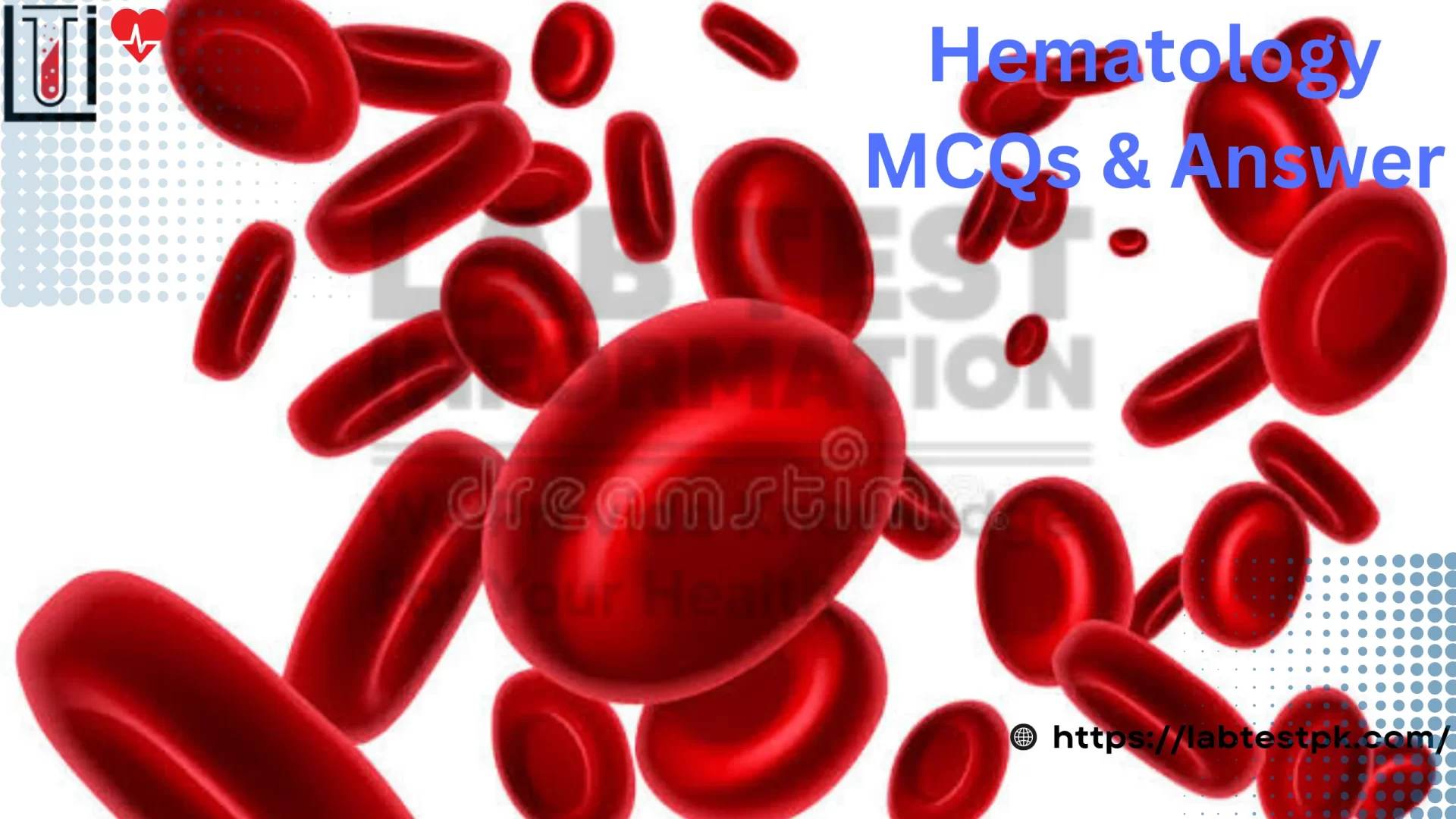Hematology MCQS Part II
Hematology MCQS Part II, Hematology Multiple Choice Questions and Answers for Competitive Exams. This hematology quiz is designed to check how well you understand the basics.
Q No. 1: Which of the following statement best defines hemophilia?
Answer:
(a) Autosomal recessive disorder affecting both sexes equally
(b) Associated with bleeding from gums and Skin
(c) Due deficiency of factor X
(d) Platelet functional defect
(e) Sex Linked disorder commonly affecting males ✓
Q No. 2: Neutropenia is defined as?
Answer:
(a) Increase in absolute neutrophil count
(b) Left shift seen in neutrophils
(c) Reduction in absolute neutrophil count ✓
(d) Reduction in total leucocyte count
(e) Right shift in neutrophils
Q No. 3: Neutrophilia is?
Answer:
(a) Decreased absolute neutrophil count
(b) Elevated absolute neutrophil count ✓
(c) Increase in total Leucocyte count
(d) Leukamoid reaction
(e) Light shift in neutrophils
Q No. 4: Which of the following is not a congenital red Blood cell membrane defect?
Answer:
(a) Hereditary elliptocytosis
(b) Hereditary ovalocytosis
(c) Hereditary Spherocytosis
(d) Hereditary sphstomatorytosis
(e) Thalassemia ✓
Q No. 5: Which of the following inclusions represents denatured hemoglobin?
Answer:
(a) Basophilic Stippling
(b) Cabot rings
(c) Heinz bodies ✓
(d) Howell Jolly bodies
(e) Pappenheimer bodies
Q No. 6: Eosinophilia does not occur in which of the following conditions?
Answer:
(a) Allergic diseases
(b) Hodgkin lymphoma
(c) Parasitic infections
(d) Skin disease
(e) Tuberculosis ✓
Q No. 7: The diagnostic test for circulatory iron overload is?
Answer:
(a) Bone marrow trephine biopsy
(b) Liver biopsy
(d) Serum ferritin ✓
(d) Serum LDH levels
(e) Total iron binding capacity
Q No. 8: Mucosal bleeding and petechiae are strongly associated with all these except?
Answer:
(a) Connective tissue disorder
(b) Haemophilia ✓
(c) Idiopathic thrombocytopenic purpura
(d) Storage load disease
(e) Von Willebrand disease
Q No. 9: Beta Thalassemia is diagnosed on?
Answer:
(a) Blood Complete picture
(b) Bone marrow examination
(c) iron profile
(d) Flow Cytology
(e) Hemoglobin electrophoresis ✓
Q No. 10: Philadelphia chromosome is the most common and distinguished feature of?
Answer:
(a) Acute lymphoid leukemia (ALL)
(b) Acute myeloid leukemia (AML)
(c) Chronic lymphoid leukemia (CLL)
(d) Chronic myeloid leukemia (CML) ✓
(e) Myelodysplastic Syndrome (MD)
Q No. 11: Does thrombocytosis occur?
Answer:
(a) Chronic idiopathic thrombocytopenic purpura
(b) Disseminated intravascular coagulation
(c) Essential thrombocythemia ✓
(d) Post-transfusion purpura
(e) Thrombotic thrombocytopenic purpura
Q No. 12: In hemophilia?
Answer:
(a) Activated Partial thromboplastin time Prolonged ✓
(b) Bleeding time Prolonged
(c) Platelet count Low
(d) Prothrombin Time Prolonged
(e) Ristocen-induced platelet aggregation Abnormal
Q No. 13: Which of the following is not a vitamin-dependent factor?
Answer:
(a) II
(b) VII
(c) IX
(d) X
(e) XI ✓
Q No. 14: The shift to the right of hemoglobin-oxygen dissociation curve mass?
Answer:
(a) Haemoglobin has an increased affinity for oxygen
(b) Lower affinity of hemoglobin for oxygen ✓
(c) Conversion of Hb to methemoglobin
(d) Failure of Hb to be oxygenated
(e) Formation of deoxyhemoglobin
Q No. 15: A Pregnant mother with A- negative blood group becomes pregnant with a 0 Positive blood group child. She had a normal delivery. and the gynecologist advised her anti-D injection. According to your knowledge what test she Should undergo before the administration of anti-D?
Answer:
(a) Ham test
(b) Isopropanol precipitation test
(c) Kleihauer Betke Test ✓
(d) Singer test
(e) Coombs test


[…] test, also known as the Kleihauer-Betke test, is a medical test used to determine the amount of fetal hemoglobin (HbF) in a pregnant woman’s bloodstream. This test is primarily performed in … where there is a risk of fetal-maternal hemorrhage, such as trauma during pregnancy, placental […]
[…] deficiency is inherited in an autosomal codominant manner, which means that you can inherit one abnormal gene (allele) from each parent […]
[…] Acute Lymphoblastic Leukemia (ALL): […]
[…] lymphoma (NHL). These panels help in confirming the diagnosis, determining the subtype of lymphoma, and guiding treatment decisions. The specific tests and procedures included in a CLL/lymphoma […]
[…] Thrombocytosis(b) Leukopenia(c) Pleocytosis ✓(d) […]
[…] result in different forms of sickle cell disease, such as Hemoglobin SC (HbSC) or Hemoglobin Sβ-thalassemia. These variants can have unique clinical presentations and require specialized […]
[…] Contact factor ✓(b) Platelet factor(c) Heat labile(d) Vitamin k […]
[…] Lymphoma (HL): Named after Dr. Thomas Hodgkin, who first described it in the early 19th century, Hodgkin lymphoma is characterized by the presence of a specific type of abnormal cell called Reed-Sternberg cells. […]
[…] Health Conditions: Conditions like leukemia, lymphoma, and psoriasis can cause an increase in uric acid […]
[…] with this mutation may develop MPNs, which include conditions like polycythemia vera, essential thrombocythemia, and primary […]